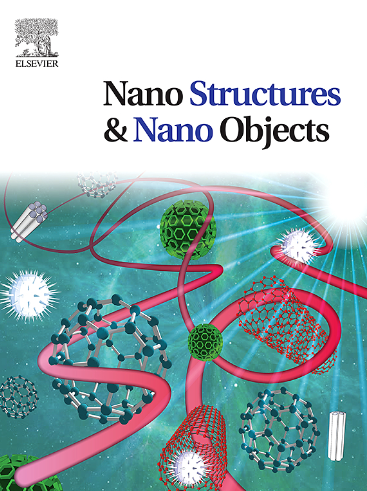Synthesis of copper nanowires and facile fabrication of nanostructured conductors with high transparency in 400–2500 nm spectral range
IF 5.45
Q1 Physics and Astronomy
引用次数: 0
Abstract
We studied the effect of parameters of a hydrothermal synthesis of copper nanowires on their dimensional characteristics. A robust protocol for the synthesis and isolation of copper nanowires with an average diameter of about 60 nm and a length of about 90 μm was developed. The final dispersion enriched with target nanowires purified from low-volatile oleylamine involved in the synthesis was used to fabricate transparent conductive films by spin coating. To increase the conductivity of the films, the rapid and efficient technique of removing the native oxide shell of nanowires utilizing the solution of formic acid in isopropyl alcohol was proposed. The fabricated transparent conductors have record-breaking characteristics: light transmittance of about 93 % (at a wavelength of 550 nm) with the sheet resistance of about 34 Ohm/sq. An important point is that the transmittance of the films with sheet resistance down to 30 Ohm/sq. exceeds 90 % in the wide spectral range (400–2500 nm), thus opening up great opportunities for applications of such nanomaterials in optoelectronics.
求助全文
约1分钟内获得全文
求助全文
来源期刊

Nano-Structures & Nano-Objects
Physics and Astronomy-Condensed Matter Physics
CiteScore
9.20
自引率
0.00%
发文量
60
审稿时长
22 days
期刊介绍:
Nano-Structures & Nano-Objects is a new journal devoted to all aspects of the synthesis and the properties of this new flourishing domain. The journal is devoted to novel architectures at the nano-level with an emphasis on new synthesis and characterization methods. The journal is focused on the objects rather than on their applications. However, the research for new applications of original nano-structures & nano-objects in various fields such as nano-electronics, energy conversion, catalysis, drug delivery and nano-medicine is also welcome. The scope of Nano-Structures & Nano-Objects involves: -Metal and alloy nanoparticles with complex nanostructures such as shape control, core-shell and dumbells -Oxide nanoparticles and nanostructures, with complex oxide/metal, oxide/surface and oxide /organic interfaces -Inorganic semi-conducting nanoparticles (quantum dots) with an emphasis on new phases, structures, shapes and complexity -Nanostructures involving molecular inorganic species such as nanoparticles of coordination compounds, molecular magnets, spin transition nanoparticles etc. or organic nano-objects, in particular for molecular electronics -Nanostructured materials such as nano-MOFs and nano-zeolites -Hetero-junctions between molecules and nano-objects, between different nano-objects & nanostructures or between nano-objects & nanostructures and surfaces -Methods of characterization specific of the nano size or adapted for the nano size such as X-ray and neutron scattering, light scattering, NMR, Raman, Plasmonics, near field microscopies, various TEM and SEM techniques, magnetic studies, etc .
 求助内容:
求助内容: 应助结果提醒方式:
应助结果提醒方式:


